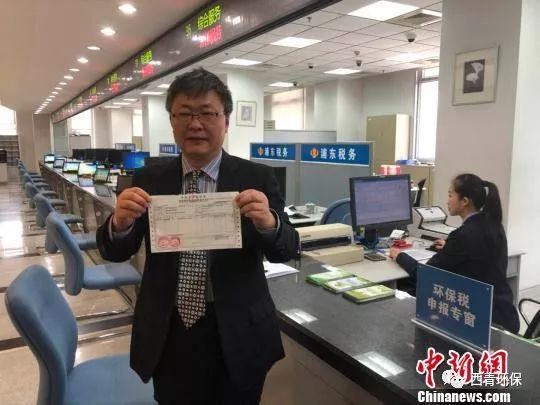


The first receipt of the environmental tax. (Photo: Chinanews)
China's first receipt of the environmental tax, promulgated on Jan. 1, 2018, was delivered on Sunday to a Shanghai new chemical material manufacturer owned by BASF SE, the world's largest chemical company.
The firm got a tax deduction of 600 yuan for fulfilling pollutant discharges up to standard, an encouragement environmental authorities proposed of factories' green shift.
The first environmental tax in China, passed by the country's top legislature at the end of 2016 which took effect at the beginning of 2018, aims to curb firms' reckless moves of emitting pollutants hazardous to the eco-system and to push them to overhaul equipment to a cleaner level, amid global competitiveness.
The tax initially applies to air and water pollution, solid waste and noise, with technical apparatus needed to precisely determine emission levels.
Cooperation between the tax and environment departments is needed to check tax bills based on data and professional advise, said Liu Ying, a professor at the Capital University of Economics and Business in Beijing.
The tax regulation adjusts itself depending on the region. Northern provinces such as Hebei and Shanxi where air pollution is the top environmental threat, slap stricter penalties with 12 yuan per equivalence (a determination method of pollution), 10 times to standard in good-air-quality districts. Regions where chemical plants are heavily located will meet harsh restrictions in checking water pollutants, with the highest tax level of 14 yuan per equivalence.
The tax system also pushes China to narrow the gap with Western peers in fulfilling a green economy. Western countries started the green control on plants as early as in 1970s when the Netherlands spearheaded a surface water tax bill. In 1995, the Netherlands Green Committee was set up to push forward environmental protection measures.
The US followed by introducing flexible policies in favor of a balance between beefing up industry and preserving the eco-system. The EU incorporated a subsidiary system in 2003 to protect agricultural landscapes in its ongoing green campaign, a milestone move to ensure food safety.
 Fire brigade in Shanghai holds group wedding
Fire brigade in Shanghai holds group wedding Tourists enjoy ice sculptures in Datan Town, north China
Tourists enjoy ice sculptures in Datan Town, north China Sunset scenery of Dayan Pagoda in Xi'an
Sunset scenery of Dayan Pagoda in Xi'an Tourists have fun at scenic spot in Nanlong Town, NW China
Tourists have fun at scenic spot in Nanlong Town, NW China Harbin attracts tourists by making best use of ice in winter
Harbin attracts tourists by making best use of ice in winter In pics: FIS Alpine Ski Women's World Cup Slalom
In pics: FIS Alpine Ski Women's World Cup Slalom Black-necked cranes rest at reservoir in Lhunzhub County, Lhasa
Black-necked cranes rest at reservoir in Lhunzhub County, Lhasa China's FAST telescope will be available to foreign scientists in April
China's FAST telescope will be available to foreign scientists in April "She power" plays indispensable role in poverty alleviation
"She power" plays indispensable role in poverty alleviation Top 10 world news events of People's Daily in 2020
Top 10 world news events of People's Daily in 2020 Top 10 China news events of People's Daily in 2020
Top 10 China news events of People's Daily in 2020 Top 10 media buzzwords of 2020
Top 10 media buzzwords of 2020 Year-ender:10 major tourism stories of 2020
Year-ender:10 major tourism stories of 2020 No interference in Venezuelan issues
No interference in Venezuelan issues
 Biz prepares for trade spat
Biz prepares for trade spat
 Broadcasting Continent
Broadcasting Continent Australia wins Chinese CEOs as US loses
Australia wins Chinese CEOs as US loses